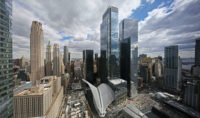Speyside, in Northeast Scotland, is the heart of the Scotch whisky industry, with some 50 distilleries across a relatively compact area. Of the many premium brands based here, one of the leaders is the Macallan Distillers, right at the heart of the region. To expand production and enable public engagement, the company has reinvented itself with a remarkable new distillery and visitor center designed by Rogers Stirk Harbour + Partners (RSH+P)—a project won through competition. The resulting building puts the manufacturing process on display while also responding to, and enhancing, the landscape.
Additional Content:
Jump to credits & specifications
This is an industrial complex in protected countryside, perched on a hillside rather than in a valley bottom, as is more typical for this water-intensive enterprise. A network of underground pipes connects it to the Spey River and to boreholes on the Macallan property. It is a large, $185 million building: 656 by 200 feet, with an internal height of up to 50 feet on two levels. The challenge the architects set themselves, says partner in charge Graham Stirk, was to respond to the setting so that the building “just becomes part of the land.” Aligned with the historic heart of the 139-acre estate—the 1700 Easter Elchies house, now used for corporate entertaining—the new building sits beneath an undulating meadow-covered roof that is tucked into the slope.
Set within an enhanced landscape by U.K.-based Gillespies, the structure’s green covering of Scottish grasses and flowers tops a hybrid timber-and-steel roof comprising five linked domes that collectively form a gridshell. The grid is made of 10-foot-square laminated veneer lumber (LVL) cassettes. Each of the domed modules is clasped by exposed gray-painted tubular steel members. This dramatic roof sits lightly on top of a sunken concrete box that forms the base for the visitor center and distillery equipment.
Each module is defined by a particular function. The visitor center is beneath the biggest dome, at the entrance. The distillery occupies the remaining four, with circular formations of large stainless-steel tanks and copper-snouted stills dominating the first three of these production zones, and the last one given over to the first stage of the fermentation process, containing an enormous circular “mash tun.” If the distillery needs to expand further, the design will accommodate the addition of more modules.
There are echoes of other RSH+P wave-form buildings, such as the 2005 terminal at the Madrid-Barajas Airport and the 2008 Bodegas Protos winery, also in Spain. The intent was not invisibility—from above, the form of the building is clearly visible—but rather to create an appropriate man-made intervention: Stirk cites ancient Scottish burial mounds. Daylight comes from the glazed flank of the building, looking out over the valley of the Spey. Integration of disciplines was key, ranging from Arup, responsible for the engineering, to the local copper still-maker Forsyths, who created the curious birdlike pot-stills unique to Macallan—fully exploited visually by the architects in their circular arrangements.
As a visitor, you arrive along a meandering lane that tempts you with a view of the building from above, then takes you back on a descending S-bend until you reach a surprisingly small parking lot (Macallan wants no more than 30,000 visitors a year, and no tourist buses). From there, you walk toward the old house and then turn to follow a long pedestrian ramp known as “the cut” up to the visitor entrance. (The distillery operation is serviced via a separate, sunken spine road along the back of the building, which also conceals storage tanks.)
The visitor center in the lofty first dome contains a reception area, shop, and restaurant; the tours start upstairs and finish there for the whisky-tasting at the end. In a circular chamber belowground, an exhibition “warehouse” houses special customer-owned casks around the walls. It’s a fine piece of visual theater—a catacomb of whisky—but it is also functional: climatic conditions there are designed to align with those of a normal aboveground warehouse.
A special fire-safety strategy based on supersensitive constant-sampling smoke detection and rapid drainage to the outside was necessary. According to Stirk, you don’t want a pool of burning spirits in what he likens to a petrochemical plant. The design avoids sprinklers or any other intrusive ceiling-mounted equipment. However, in an industry first, sprinklers are installed along the top of the glass wall between the public area and distillery, providing a two-hour fire barrier while preserving the desired transparency. The domed structure is also a good shape for everyday constant ventilation, as distilling is a hot, steam-powered business: the vents are deliberately expressed on the outside of the dome, projecting through the rooftop meadow.
When I visited, the undulating green roof had turned brown in the driest heatwave since 1976—usually this is a rainy part of Scotland. Over time, and with correct use of the integral irrigation system, it should green up and get quite shaggy. That issue aside, the distillery was operating smoothly both as a factory and as a tourist destination. “It’s supposed to be a mystery revealed, a Jules Verne–like interior,” says Stirk. The design team has succeeded: seldom has an industrial process seemed quite so seductive. But then, this is an industry devoted to one of mankind’s more refined pleasures.
CreditsArchitect: Rogers Stirk Harbour + Partners—Graham Stirk, senior partner; Toby Jeavons, associate partner
Engineering: Arup (structural/services/fire)
Consultants: Gillespies (landscape architect); Speirs + Major (lighting design); Atelier Bruckner (visitor experience and exhibition design); Forsyths (distillery)
General contractor: Robertsons Construction Group; Sheppard Engineering Services |
SpecificationsRoof Topek (green); Weihag (timber gridshell)
Glazing Glassolutions (facade)
Concrete Decomo (precast)
Polished plaster Armourcoat
Ceilings Kvadrat (acoustic); BCL (timber)
Resin floor Flowcrete |












